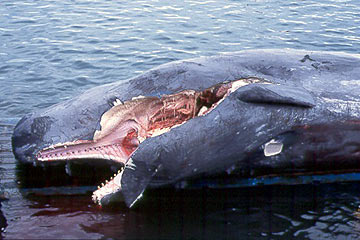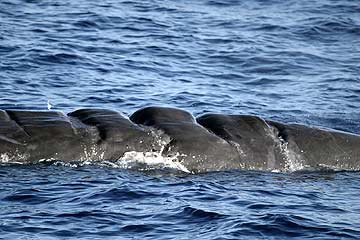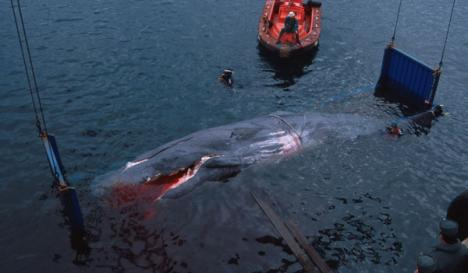Vessel Strikes

Sperm whale struck by high speed ferry. Photo by Vidal Martin
There has been a nearly 500% increase in reported whale vessel strikes in Hawaiian waters since reports were tabulated in 1975.
Boat speed is clearly a factor in the incidence of collisions, with about 80% of all strikes occurring with vessels traveling between 10-30 knots. Collisions resulting in severe injury or death are typically caused by boats traveling at 14 knots or higher.
Tour boats have the highest strike incidence (38%) followed by recreational boats, with 12%.
50% of all strikes occur suddenly, with no warning, making it impossible for vessels to take evasive action to avoid collisions. Strikes with motorized vehicles are ten times higher than those with sailboats, and 57% of all strikes involve calves or juvenile whales (22).
Speed regulations should be put in place with adequate monitoring and enforcement provision (5,9,11, 14, 20, 22,30, 33, 37, 39).
The research suggests an introduction of a speed limitation of 13 knots for any high-risk area and existing Special Areas of Conservation, respectively (20).
The research suggests an introduction of a mandatory reporting scheme for collisions (38).
Not all strikes are immediately fatal; many cause fatal internal injuries, infection etc. that result in premature death caused by the strike. (20, 30, 33, 38).
Cetaceans can also be harassed or displaced from an area valuable to the individual or population by boat speed (2, 5, 11, 23, 24, 28, 36).
Around a third of humpback whales found dead along the US Atlantic coast between 1985-1992 had injuries caused by ships. It is important to note that many of these animals did not show external signs of trauma and ship strike injuries were only detected through comprehensive necropsies. Since not all reported dead humpbacks are necropsied, these data represent a minimal estimate of the impacts from vessel strikes to this species (40).
Tidal patterns and other geographical factors make it likely that most
fatally-struck carcasses are never retrieved. For instance, they probably never get seen because of limited offshore effort. A large number of them likely sink (40).
A witness has to report a definite or probable collision with a cetacean or sight a carcass. The problem is that, if a cetacean collides with a very large vessel of tanker size, or similar, the impact might not be felt as it would in a smaller vessel. Similarly, if collisions occur at night, then witnesses may not be present or may not be able to see clearly what has happened. There is also a
concern in the US of liability – which results in some vessels not reporting (40).
Wiley et al. (1994) have demonstrated that if the humpback whales they studied had not had a necropsy performed on them it would not have been discovered that the whales died from internal injuries caused by ship strikes. (40).
Under-recording contributes to the problem. Strikes may be under-reported for a variety of reasons, including a lack of awareness of the issue and a lack of knowledge of how and where to report actual, or apparent, collisions (13).
Numerous incidences of collisions between whales and whale-watching vessels during watching time are documented (17, 20).

Propellor scars. Photo by Chris Johnson.
1) ACCOBAMS. ‘Fins’ Newsletter of ACCOBAMS (Agreement on the Conservation of Cetaceans of the Black Sea, Mediterranean Sea and Contiguous Atlantic Area). Ship strike special feature. Vol 3 (1): 12-
19, August 2006. ACCOBAMS (cf http://www.iwcoffice.org/_documents/sci_com/SC58docs/sc58docs.htm)
2) Andre, M. & Potter, J.R. 2000. Fast-ferry acoustic and direct physical impact on cetaceans: evidence, trends and potential mitigation. Proceedings of the fifth European Conference on Underwater Acoustics. European Commission Community Research. ISBN92-828-9531-9.
3) Andre, M. 1998. The conservation status of cetaceans: A case study in the Canary Islands. Proceedings of the Morecambe Seminar, Theme II: Key Scientific Issues.
4) Australian National Guidelines for Whale and Dolphin Watching, 2005. 20pp. (http://www.deh.gov.au/coasts/publications/pubs/whale-watching-guidelines-2005.pdf)
5) Asmutis-Silvia, Regina. 1999. An Increased Risk to Whales Due to High-Speed Whale Watching Vessels. International Whaling Commission SC/51/WW11.
6) Behrens, S. & Constantine, R. 2008. Large Whale and Vessel Collisions in Northern New Zealand, School of Biological Sciences, University of Auckland, New Zealand. Report to the International Whaling Commission, SC/60/BC9.
7) Calleson, C.S. & Frohlich, R.K. 2007. Slower Boat Speeds reduce risk to Manatees. Endangered Species Research. Vol 3: 295-304.
8) Carrillo, M. & Ritter, F. 2008. Increasing Numbers of Ship Strikes in the Canary Islands: Proposals for Immediate Action to Reduce Risk of Vessel Whale Collisions. Canarias Conservation, Maya 8, 38204. International Whaling Commission Document SC/60/BC 6
9) Cole, T., Hartley, D. and Garron, M. (2006) Mortality and Serious Injury Determinations for Baleen Whale Stocks along the Eastern Seaboard of the United States, 2000-2004. U.S. Department of Commerce Northeast Fisheries Science Centre. Reference Document 6-04; 18 p. Available from: National Marine Fisheries Service, Woods Hole, MA 02543-1026
10) Douglas, A.B., Calambokidis, J., Raverty, S., Jeffreys, S.J., Lambourn, Da.M. & Norman, S.A. 2008. Incidents of Ship Strikes of Large Whales in
Washington State. Journal of the Marine Biological Association of the United Kingdom. doi:10.1017/S0025315408000295, Published online by
Cambridge University Press 17 March 2008.
11) Dolman, S. V. Williams-Grey, R. Asmutis-Silva, S. Isaac. 2006. Vessel Collisions and Cetaceans: What happens when they don’t miss the boat. Whale and Dolphin Conservation Society Science Report.
12) Félix, F. and Van Waerebeek, K. 2005. Whale Mortality from Ship Strikes in Ecuador and West Afrika. LAJAM 4(1): 55-60. Ship Strike Working Group,. 2006. First Progress Report to the Conservation Committee. Int. Whal. Commn. Scietific Committee: SC/58/CC3.
13) Félix, F; Waerebeek WV; 2005. Whale mortality from ship collisions underreported, case studies from Ecuador and West Africa. Report to the Scientific Committee of the International Whaling Commission. SC/57/BC1.
14) Firestone, J. 2009. Policy Considerations and Measures to Reduce the Likelihood of Vessel Collisions with Great Whales. Environmental Affairs. Vol.36:389
15) IMO, 2007. Work Programme of the Committee and subsidiary bodies – Measures for minimizing the Risks of Collisions with Cetaceans. Marine
environment Protection Committee: MEPC 57/18/2
16) IWC. 2008. Third Progress Report to the Conservation Committee of the Ship Strike Working Group. Int. Whal. Commn. Scientific Committee
IWC/60/CC3.
17) Jensen, A.S. and Silber, G.K. 2004. Large Whale Ship Strike Database. U.S. Department of Commerce, NOAA Technical Memorandum.
NMFS-F/OPR-25, January 2004. 37 pp.
18) Knowlton, A.R. and Kraus, S.D. 2001. Mortality and serious Injuryof Northern Right Whales (Eubalaena glacialis) in the Western North Atlantic
Ocean. Journal for research and Management (Special Issue) 2, 193-208.
19) Koschinski, S. 2002. Ship collisions with whales. A report prepared for the Eleventh Meeting of the CMS Scientific Council, Bonn, September 2002. 19pp.
20) Laist, D.W., Knowlton, A.R., Mead, J.G, Collet, A.S., and Podesta, M. 2001. Collisions between Ships and Whales. Marine Mammal Science 17(1):35-75.
21) Lammers, M.O., Pack, A.A. & Davis, L. 2007. Trends in Whale/Vessel Collisions in Hawaiian Waters. Int. Whal. Commn. Scientific Committee
SC/59/BC14.
22) Lammers, M.O; Pack, A.A; Davis, L. 2003. Historical evidence of whale/ vessel collisions in Hawaiian waters (1975-present). OSI Technical Report 2003-01.
23) Lott, R.,Williams-Grey, V. and Simmonds, M. 2006. Responsible whale watching: the way forward. Report to the Scientific Committee of the International Whaling Commission. SC/58/WW4
24) McCauley, Robert D.; Cato, 2001, Douglas H. The underwater noise of vessels in the Hervey Bay (Queensland) whale watch fleet and its impact on humpback whales The Journal of the Acoustical Society of America, 109(5, Pt. 2); p. 2455
25) Panigada, S. 2006. Ship Strikes in the Mediterranean Sea and the ACCOBAMS activities. Special – Ship Strikes. Vol. 3 (1), August 2006. pp
12.
26) Pesante, G., Collet, A., Dhermain, F., Frantzis, A., Panigada, S., Podestà, M. And Zanardelli M. 2002. Review of Collisions in the Mediterranean Sea. In: Pesante G., Panigada S. and Zanardelli M. (eds). Proceedings of the 27) Workshop: Collisions between Cetaceans and Vessels: Can we find Solutions? 15th Annual Meeting of the European Cetacean Society in Rome, 2001. ECS Newsletter No. 40:5-12
(Special Issue).
28) Ritter, F. 2003. Interactions of Cetaceans with Whale-Watching Boats – Implications for the management of Whale-Watching Tourism. A
Report based on the Findings of the Research Project M.E.E.R. La Gomera, March 2003. M.E.E.R. e.V., Berlin, Germany, 91pp.[Available
from the authors].
29) Ritter, F. 2007. A Quantification of Ferry Traffic in the Canary Islands (Spain) and its Significance for Collisions with Cetaceans. Int. Whal. Commn. Scientific Committee SC/59/BC7.
30) Rodriguez, M.C., Garcia, E. & Poleo, A. 2005. High speed Crafts in the Canary Islands. Journal of Maritime Research, Vol.II (2), pp.81-91.
31) Tejedor, A., Sagarminaga, R., Canadas, A., De Stepanis, R. & Pantoja, J. 2007 Modifications of Maritime Traffic off southern Spain. Int. Whal.
Comm. Document SC/59/BC 13.
32) Tregenza, N; Aguilar, N; Carrillo, M; Delgado, I; Díaz, F; Brito, A; Martin, V. 2000. Potential impact of fast ferries on whale populations. A simple model with examples from the Canary Islands. European
Research on Cetaceans, 14: 195-197.
33) Vanderlaan, A.S.M. and Taggart, C.T. 2007. Vessel Collisions with Whales: The Probability of lethal Injury based on Vessel Speed. Marine
Mammal Science, 23.1 : 144-156.
34) Van Waerebeek, K., Baker, A.N., Félix, F., Gedamke, J., Iniguez, M., Sanino, G.P., Secchi, E., Sutaria D., van Helden, A. and Wang Y. 2007. Vessel Collisions with Small Cetaceans Worldwide and with Large Whales in the Southern Hemisphere.An Intitial Assessment. LAJAM 6(1): 43-69.
35) Visser, I N & Fertl, D 2000. Stranding, resighting, and boat strike of a killer whale (Orcinus orca) off New Zealand. Aquatic Mammals 26(3): 232-240
36) Watkins, W. A. 1986. ‘Whale reactions to human activities in Cape Cod waters.’ Marine Mammal Science. 2(4):251-262.
37) Weinrich, M. 2004. A review of worldwide collisions between whales and fast ferries. J. Cetacean Res. Manage. Report to the Scientific Committee of the International Whaling Commission. SC/56/BC9.
38) Van Waerebeek, K. and Leaper, R. (compilers) 2007. Report from the IWC Vessel Strike Data Standardization Group. Document SC/59/BC12.
39) Weinrich M. 2004. A Review of worldwide collisions between whales and fast ferries. Int. Whal. Commn. Scientific Committee SC/56/BC9.
40) Wiley, D. N., R. A. Asmutis, T. D. Pitchford and D. P. Gannon. 1994. ‘Stranding and mortality of humpback whales, Megaptera novaeangliae, in the mid-Atlantic and southeast United States, 1985-
1992. Fishery Bulletin, U.S. 93:196-205.
41) Federal Register/ Vol. 71, No. 122/ Monday, June 26, 2006 Proposed Rules 36299. Department of Commerce National Oceanic and Atmospheric Administration 50 CFR Part 224
Endangered Fish and Wildlife; Proposed Rule to Implement Speed Restrictions to Reduce the Threat of Ship Collisions with North Atlantic Right Whales.
Research compiled by Nina Monasevitch, 2010

Sperm Whale killed by fast ferry in Canary Islands.
